SUMMER’S LAST WILL AND TESTAMENT.
EDITION.
A pleasant Comedie, called Summer’s last will and Testament. Written by Thomas Nash. Imprinted at London by Simon Stafford, for Water Burre. 1600. 4to.
[Collier’s preface.]
[Thomas Nash, son of William Nash, minister, and Margaret his wife, was baptized at Lowestoft, in Suffolk, in November 1567.[1] He was admitted a scholar at St John’s College, Cambridge, on the Lady Margaret’s foundation, in 1584, and proceeded B.A. in 1585:] the following is a copy of the Register:—
“Tho. Nashe Coll. Joh. Cantab. A.B. ib. 1585.” The place, though not the time, of his birth[2] we have under his own authority, for in his “Lenten Stuff,” printed in 1599, he informs us that he was born at Lowestoft; and he leads us to conclude that his family was of some note, by adding that his “father sprang from the Nashes of Herefordshire."[3]
It does not appear that Nash ever proceeded Master of Arts at Cambridge, and most of his biographers agree that he left his college about 1587. It is evident, however, that he had got into disgrace, and probably was expelled; for the author of “England to her three Daughters” in “Polimanteia,” 1595, speaking of Harvey and Nash, and the pending quarrel between them, uses these terms: “Cambridge make thy two children friends: thou hast been unkind to the one to wean him before his time, and too fond upon the other to keep him so long without preferment: the one is ancient and of much reading; the other is young, but full of wit."[4] The cause of his disgrace is reported to have been the share he took in a piece called “Terminus et non Terminus,” not now extant; and it is not denied that his partner in this offence was expelled. Most likely, therefore, Nash suffered the same punishment.
If Nash be the author of “An Almond for a Parrot,” of which there is little doubt, although his name is not affixed to it, he travelled in Italy;[5] and we find from another of his pieces that he had been in Ireland. Perhaps he went abroad soon after he abandoned Cambridge, and before he settled in London and became an author. His first appearance in this character seems to have been in 1589, and we believe the earliest date of any tract attributed to him relating to Martin Marprelate is also 1589.[6] He was the first, as has been frequently remarked, to attack this enemy of the Church with the keen missiles of wit and satire, throwing aside the lumbering and unserviceable weapons of scholastic controversy. Having set the example in this respect, he had many followers and imitators, and among them John Lily, the dramatic poet, the author of “Pap with a Hatchet.”




